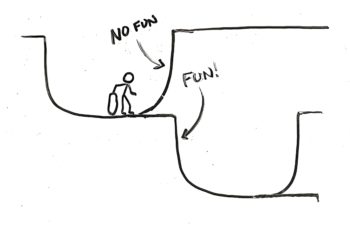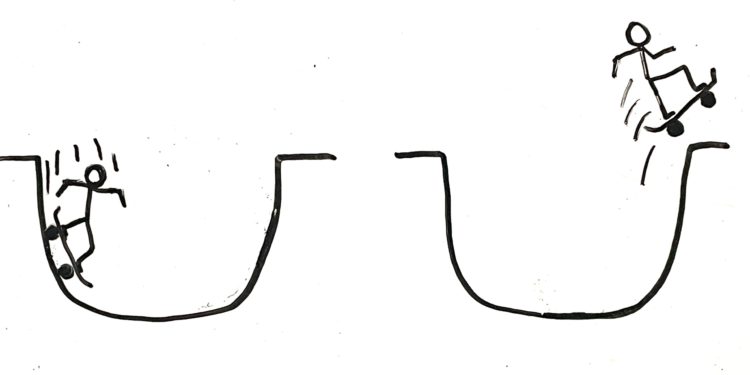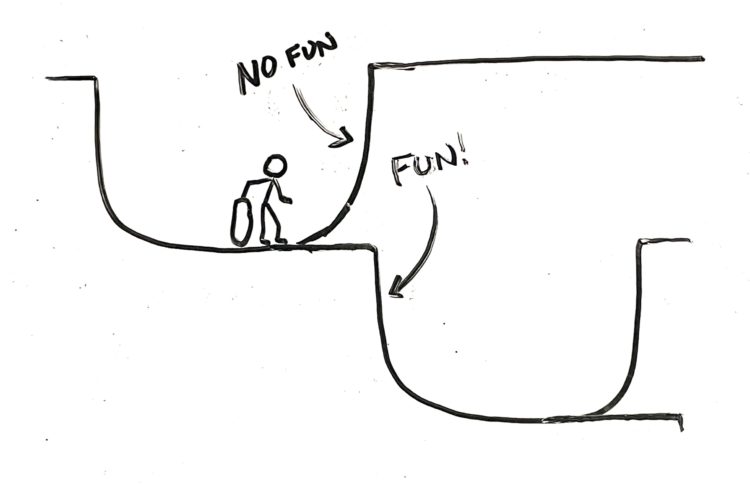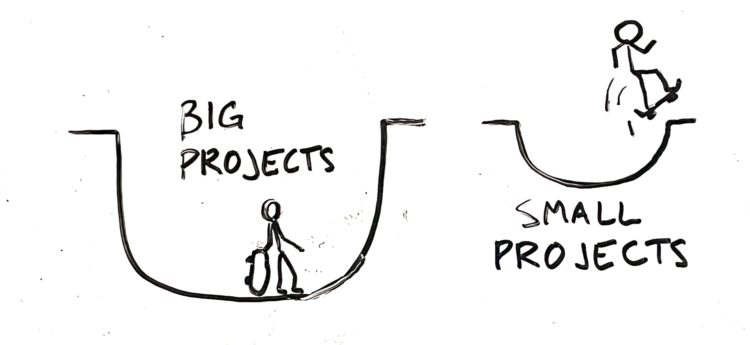Subscribe to blog updates via email »
The Project Halfpipe – Love Your Work, Episode 291
 A creative project is like a halfpipe. The depth of the halfpipe from which you must ascend to finish a project is equal to the height of the optimism that prompted you to begin. But there’s a way to build your project halfpipe so the project itself keeps you moving forward.
A creative project is like a halfpipe. The depth of the halfpipe from which you must ascend to finish a project is equal to the height of the optimism that prompted you to begin. But there’s a way to build your project halfpipe so the project itself keeps you moving forward. Listen to the Podcast
- Listen in iTunes >>
- Download as an MP3 by right-clicking here and choosing “save as.”
- RSS feed for Love Your Work
The gravity of optimism pulls you into a project
When you begin a project, you are optimistic. Why else would you start? You’re interested in the subject matter, and you expect to succeed. This optimism serves as the gravity that pulls you into the project halfpipe.Without experience, you can’t maintain the momentum to finish
The momentum you build from this drop into the halfpipe may get you through much of the project, but will eventually run out. By the time you get to the other side of the halfpipe – the end of the project – you’ve forgotten the optimism you once had, and the friction of reality has sapped your energy. The project isn’t as fun as it once was, and it hasn’t been as easy as you had expected. You face a steep incline, and don’t have the momentum to ascend. Experienced skateboarders know how to tweak their momentum, so they have enough energy to ascend the other side of a halfpipe. Like kicking their legs while riding a swing, they’re able to climb higher and higher, as they go back and forth. Experienced creators know how to tweak their motivation, too, to ascend the other side of the halfpipe. They’ve finished enough projects, they know how to harness their momentum to make the most of their efforts, and coast through the tough parts. But the need for this experience is a catch-22: You don’t know how to tweak your motivation to follow through if you haven’t finished projects, and if you haven’t finished projects you don’t know how to tweak your motivation.A halfpipe is a closed system
A halfpipe, with nothing but a skateboard rolling back and forth, is a closed system. The first law of thermodynamics states that energy can neither be created nor destroyed. The energy from the descent into the halfpipe is not enough to get to the other side of the halfpipe, because much of it is wasted on friction. When you put a person on the skateboard, that adds a new energy source to the system. The skateboarder can move their body in ways that overcome the loss of energy from friction, thus maintaining enough momentum to get out of the halfpipe. But the skateboarder is a closed system, too. They require energy to move.
When you put a person on the skateboard, that adds a new energy source to the system. The skateboarder can move their body in ways that overcome the loss of energy from friction, thus maintaining enough momentum to get out of the halfpipe. But the skateboarder is a closed system, too. They require energy to move. 
Shiny object syndrome sets in when projects get tough
Shiny object syndrome often sets in toward the end of a project. There are other halfpipes all around. The excitement of dropping into one and once again experiencing effortless momentum is a lot more fun than putting forth effort to get out of the current halfpipe. So, you switch projects – you switch halfpipes. Some creators, after dropping into enough halfpipes, figure out how to tweak their motivation to get through one – whether due to luck or experimentation. More often, they get frustrated with the endless cycle of shiny object syndrome, and burn out. They stop “skating” altogether.
Some creators, after dropping into enough halfpipes, figure out how to tweak their motivation to get through one – whether due to luck or experimentation. More often, they get frustrated with the endless cycle of shiny object syndrome, and burn out. They stop “skating” altogether. You learn to maintain momentum by finishing projects
But, you can turn the closed system of a halfpipe into an open system that maintains your momentum, propelling you to the finish. If you use this method to finish more projects, you’ll gain experience tweaking your motivation. Maybe you need an accountability partner – or maybe you hate obligation. Maybe you gain momentum by building prototypes – or maybe you prefer to develop a detailed plan. Maybe you like to talk about ideas with friends – or maybe you discover it causes you to lose your momentum.Do smaller projects, finish more projects
If you aren’t finishing projects, you can’t learn what works for you. A great way to finish more projects is simply do smaller projects. When you do smaller projects, two things happen: One, you make the halfpipe shorter, and less shallow, so you don’t run out of momentum so fast, and you can more easily find the internal motivation to get out of the halfpipe. Two, you can more easily get momentum from the project itself, in the form of feedback loops. For example, when I’m working on a new book, I don’t just sit down and write a book. That’s too long and deep a halfpipe. I might be excited going in, but I’ll soon lose momentum, and I’ll forget why I began in the first place. Instead, I break the process of writing into tiny projects, which feed into progressively larger projects. I write and share an idea on Twitter. If it does well on Twitter, I expand it into a newsletter. If it does well as a newsletter, I expand it into an article and podcast episode. After I complete this process enough times, I have a large collection of ideas I can share in my book. There’s still a lot of work to be done: I need to weave the ideas together into a cohesive whole, not to mention edit the book, lay it out, design the cover, and market it. But that bigger halfpipe of writing the book is much easier to get through when fueled by the momentum of the smaller halfpipes of tweets, newsletters, and articles. In fact, through these smaller projects with feedback loops, my halfpipe is no longer a closed system. The projects themselves are providing the momentum. Big projects are like halfpipes: You lose momentum and get stuck. Small projects are like waves: Feedback loops keep you moving forward.
For example, when I’m working on a new book, I don’t just sit down and write a book. That’s too long and deep a halfpipe. I might be excited going in, but I’ll soon lose momentum, and I’ll forget why I began in the first place. Instead, I break the process of writing into tiny projects, which feed into progressively larger projects. I write and share an idea on Twitter. If it does well on Twitter, I expand it into a newsletter. If it does well as a newsletter, I expand it into an article and podcast episode. After I complete this process enough times, I have a large collection of ideas I can share in my book. There’s still a lot of work to be done: I need to weave the ideas together into a cohesive whole, not to mention edit the book, lay it out, design the cover, and market it. But that bigger halfpipe of writing the book is much easier to get through when fueled by the momentum of the smaller halfpipes of tweets, newsletters, and articles. In fact, through these smaller projects with feedback loops, my halfpipe is no longer a closed system. The projects themselves are providing the momentum. Big projects are like halfpipes: You lose momentum and get stuck. Small projects are like waves: Feedback loops keep you moving forward. Turn halfpipes into waves
When you surf a wave, gravity is still pulling you down the face of the wave, but the wave itself is moving, too. This is why you sometimes hear the expression of “riding a wave,” in business. The success of an industry or trend becomes an outside force that keeps you moving, multiplying your efforts. The success of a project itself can become a wave, too. As blogger Tynan has pointed out, one reason it’s hard to finish projects is that in the middle of the project, you’ve experienced all the downsides of working on the project, but none of the upsides of succeeding. You’re stuck in the halfpipe. But if you design the project so you get some of that feedback throughout the process, you get to experience some upsides that keep you moving. This works for a lot of creative projects. You can’t count the number of stand-up comedians who go to one open mic after another, testing out jokes, then take those jokes on the road to polish them, then weave it all together into a one-hour special, then repeat the process over again. Even War and Peace, written when publishing wasn’t so rapid and didn’t have such immediate feedback, was published serially, with a different name, and wasn’t even intended to be a novel. It wasn’t until later that Tolstoy wove it together, and re-wrote it.
As blogger Tynan has pointed out, one reason it’s hard to finish projects is that in the middle of the project, you’ve experienced all the downsides of working on the project, but none of the upsides of succeeding. You’re stuck in the halfpipe. But if you design the project so you get some of that feedback throughout the process, you get to experience some upsides that keep you moving. This works for a lot of creative projects. You can’t count the number of stand-up comedians who go to one open mic after another, testing out jokes, then take those jokes on the road to polish them, then weave it all together into a one-hour special, then repeat the process over again. Even War and Peace, written when publishing wasn’t so rapid and didn’t have such immediate feedback, was published serially, with a different name, and wasn’t even intended to be a novel. It wasn’t until later that Tolstoy wove it together, and re-wrote it. The next time you find yourself stuck in a project halfpipe, or switching to new projects each time a previous project gets tough, see if you can turn that halfpipe into a wave. Complete smaller projects that give you immediate feedback. You’ll finish more projects, and learn to tweak your motivation well enough to soar out of larger and larger halfpipes.
Thank you for having me on your podcasts!
Thank you for having me on your podcasts. Thank you to Ivan Farber at the Conversations About Conversations podcast. As always, you can find interviews of me on my interviews page.Join the Patreon for (new) bonus content!
I've been adding lots of new content to Patreon. Join the Patreon »
Subscribe to Love Your Work
Listen to the Podcast
- Listen in iTunes >>
- Download as an MP3 by right-clicking here and choosing “save as.”
- RSS feed for Love Your Work
Theme music: Dorena “At Sea”, from the album About Everything And More. By Arrangement with Deep Elm Records. Listen on Spotify »



